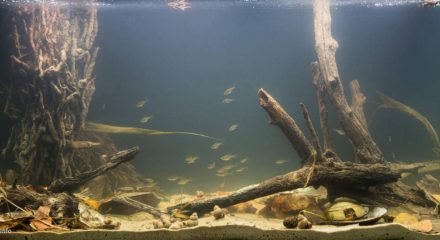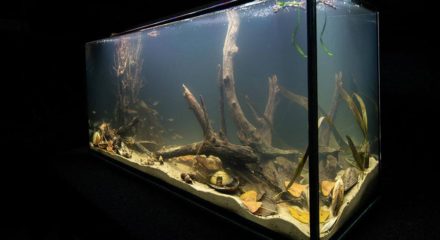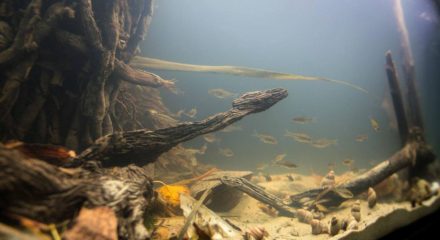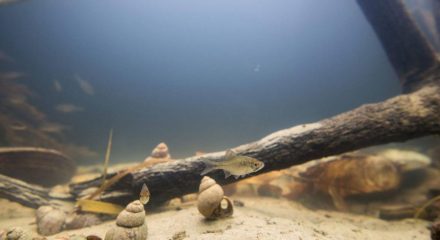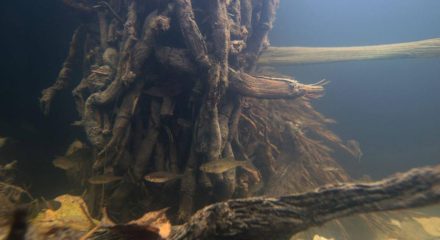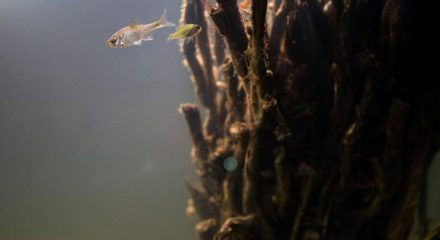Quiet dam near Dikanka, Garaganka River, Poltava region, Ukraine
12th place in Biotope Aquarium Design Contest 2016
![]() Ukraine. Anastasia Tytova
Ukraine. Anastasia Tytova
Aquarium Volume: 250 L
Fish and invertebrates: Rhodeus sericeus, Lepomis gibbosus, Pseudorasbora parva, Anodonta, Viviparus viviparus, Astacus astacus
Plants list: None
Biotope description: Traveling in the Poltava region, I came across a body of water. I was impressed by fallen trees, the driftwood sprawled across the bank and dry bushes sticking out of the water. But especially by huge shell clams that were the size of my two hands. Not only we seated on snags, but also the fishermen on the river bank. In their buckets there were perches. The peasants with fishing rods surprisingly glanced as I ran along the beach collecting dirty muddy shells. What, are you looking for the treasure? – a fisherman asked. Treasures are not the same – he lamented – there is less fish now, I fish here for forty years. Fish is displaced. Pike, carp are a wonder. It turned out that over the past 15 years in the water bodies of Ukraine 18 new species of fish were registered. I had an idea to create a biotope aquarium, to draw attention to the problem of changes in the natural balance of the water bodies in Ukraine, where today the population of invasive species is more than earlier. Some of the new species were introduced, some spread on their own, and some species came from aquariums. Their number is constantly growing, but the native species such as perch, pike, roach, carp, crucian carp are becoming increasingly rare. Twenty walks with a net along the shore brought me sunshine bass, bitterling and stone moroko. And what’s the use? – the fisherman continued. After collecting driftwood, reeds and snails, I went home to make world of Garaganka river. Though Garaganka is a small river, it has bays and deep parts. Along the river mainly poplar, willow, maple grow. Another plant that grows in abundance on the shores of Garaganka is Scirpus. At the bottom of the river there is mud, sand, a lot of fallen trees and driftwood, overgrown with thread algae that Rhodeus sericeus eat. On the bottom there are Unio and freshwater molluscs Anodonta inside which Rhodeus sericeus lays eggs on the second year of its life. There are also Viviparus viviparus there. I hope my biotope aquarium will help to pay attention to the fact that these spesies capture more water areas, forcing local aquatic organisms, altering the ecology of water bodies of Ukraine.
Fish and invertebrates: Rhodeus sericeus, Lepomis gibbosus, Pseudorasbora parva, Anodonta, Viviparus viviparus, Astacus astacus
Plants list: None
Biotope description: Traveling in the Poltava region, I came across a body of water. I was impressed by fallen trees, the driftwood sprawled across the bank and dry bushes sticking out of the water. But especially by huge shell clams that were the size of my two hands. Not only we seated on snags, but also the fishermen on the river bank. In their buckets there were perches. The peasants with fishing rods surprisingly glanced as I ran along the beach collecting dirty muddy shells. What, are you looking for the treasure? – a fisherman asked. Treasures are not the same – he lamented – there is less fish now, I fish here for forty years. Fish is displaced. Pike, carp are a wonder. It turned out that over the past 15 years in the water bodies of Ukraine 18 new species of fish were registered. I had an idea to create a biotope aquarium, to draw attention to the problem of changes in the natural balance of the water bodies in Ukraine, where today the population of invasive species is more than earlier. Some of the new species were introduced, some spread on their own, and some species came from aquariums. Their number is constantly growing, but the native species such as perch, pike, roach, carp, crucian carp are becoming increasingly rare. Twenty walks with a net along the shore brought me sunshine bass, bitterling and stone moroko. And what’s the use? – the fisherman continued. After collecting driftwood, reeds and snails, I went home to make world of Garaganka river. Though Garaganka is a small river, it has bays and deep parts. Along the river mainly poplar, willow, maple grow. Another plant that grows in abundance on the shores of Garaganka is Scirpus. At the bottom of the river there is mud, sand, a lot of fallen trees and driftwood, overgrown with thread algae that Rhodeus sericeus eat. On the bottom there are Unio and freshwater molluscs Anodonta inside which Rhodeus sericeus lays eggs on the second year of its life. There are also Viviparus viviparus there. I hope my biotope aquarium will help to pay attention to the fact that these spesies capture more water areas, forcing local aquatic organisms, altering the ecology of water bodies of Ukraine.
Photo Gallery
Comments of the members of the jury of Biotope Aquarium Design Contest 2016

When you read the description of this biotope, you can feel the danger that nature is facing. Overpopulation, overfishing, pollution affect every corner of Earth. Thank you for bringing up the awarness.
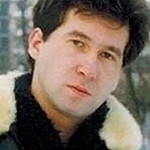
I am glad that more and more people began to pay attention to the European biotopes and raise issues related to protecting local water bodies. In my opinion, it is one of the most “truthful” works in this contest.

The first thing that drew my attention to this biotope aquarium was the “Biotope description”. The way the description was told as a story anecdote just made the aquarium so much special. It really made me feel in touch with what I was looking at. You see; you can have the greatest aquarium but if your description is vague, boring and full of mistakes, it lessens the value of the setup. I also liked the size of the fish used and the great swimming area in the middle.
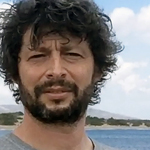
It is one of the most touching entries of this contest. Rivers of our latitudes is not as picturesque as the tropical waters. Aquatic organisms seem to be a little bit too grayish. This aquarium shows that a biotope with local species of fish can be very decorative. This is similar to our rivers. I am ready to believe that everything is true. Such aquaria inspire to set up aquaria of of our local waters. I like the shells on the bottom spread with great love. In the description there is a problem of invasive species of fish put in the waterbodies by hobbyists and displacing indigenous aquatic organisms. There are mistakes in design, but the entire aquarium leaves a pleasant impression.

